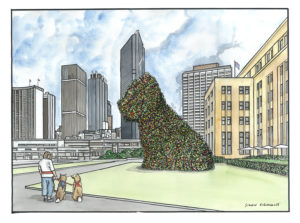
Jeff Koons' "Puppy" at the Museum of Contemporary Art, Sydney: An Enduring Icon of Artistic Innovation.Jeff Koons, a revolutionary figure in the realm of contemporary art, has left an indelible mark on the art world with his iconic creation, "Puppy." This larger-than-life sculpture has become a symbol of artistic innovation, and its presence at the Museum of Contemporary Art (MCA) in Sydney has sparked admiration, discussion, and wonder among art enthusiasts and casual observers alike.
Standing tall at the entrance of the MCA, "Puppy" is a colossal artwork depicting a West Highland terrier puppy crafted from stainless steel and adorned with an elaborate covering of vibrant flowers. The sculpture is a celebration of innocence, beauty, and the universal theme of love, evoking a sense of joy and wonder that captivates audiences of all ages. It represents a unique blend of contemporary art and popular culture, blurring the lines between high and low art and challenging conventional notions of what art should be.
Koons' "Puppy" has a compelling backstory, originating from the artist's personal experiences and reflections on the ephemeral nature of happiness and the enduring qualities of love. The use of flowers covering the sculpture not only symbolizes beauty but also reflects the cycle of life, transformation, and the passage of time. It’s a metaphor for the ever-changing nature of existence and the enduring presence of love and joy in our lives.
One of the most fascinating aspects of the sculpture is its ability to engage the audience on multiple levels. On the surface, it's an adorable and inviting piece, capturing attention with its charm and sheer size. Its colossal presence commands the space and immediately draws in passersby. However, beneath the surface, "Puppy" invites contemplation about the complexities of art and society, encouraging viewers to ponder the deeper meaning behind its whimsical façade.
Koons' "Puppy" has also become a powerful symbol of public art, transcending the confines of a traditional museum setting. Its placement at the entrance of the MCA in Sydney serves as a testament to the accessibility and inclusivity of art. It greets visitors with open arms, setting a tone of warmth and welcome, inviting them to experience the transformative power of art from the moment they arrive at the museum.
Moreover, "Puppy" has ignited discussions about the role of art in the public sphere, prompting contemplation on the impact and influence of art on our daily lives. Its ability to resonate with diverse audiences, from art connoisseurs to casual observers, speaks volumes about its universal appeal and the power of art to transcend boundaries, cultures, and backgrounds.
In conclusion, Jeff Koons' "Puppy" at the Museum of Contemporary Art in Sydney stands not only as a remarkable piece of art but also as a symbol of artistic ingenuity, accessibility, and the enduring power of love and joy. Its impact on visitors, both in its visual magnificence and its profound symbolism, cements its place as an iconic and timeless masterpiece that continues to captivate and inspire all who encounter it.
The structure of "Puppy" is primarily made from stainless steel. The framework was carefully constructed to support the weight of the massive sculpture and ensure its stability. The steel skeleton forms the foundation of the artwork, providing the necessary structure to hold the immense weight of the sculpture and withstand various weather conditions, as "Puppy" is often displayed in outdoor settings.
The most distinctive and striking aspect of "Puppy" is its covering of flowers. Thousands of live flowers and plants adorn the stainless steel frame, adding color, texture, and a lifelike quality to the sculpture. The process of applying these flowers involves a meticulous and time-consuming effort. The flowers are meticulously arranged, petal by petal, adhered to the structure to create a vibrant and intricate surface.
To maintain the sculpture's appearance, the flowers require constant care. Teams of skilled gardeners and maintenance experts regularly attend to the living flora, ensuring that the plants remain healthy, vibrant, and well-groomed. The ongoing care and maintenance of "Puppy" reflect a commitment to preserving the artwork's intended appearance, allowing it to retain its captivating allure.
Additionally, the engineering of the artwork takes into account its scale and location. Considerations such as weight distribution, wind resistance, and environmental factors are crucial in ensuring the stability and longevity of the sculpture, especially when it's displayed outdoors, exposed to the elements.
The combination of innovative structural design, meticulous craftsmanship, and ongoing maintenance is a testament to the complexity and dedication involved in creating and preserving such a monumental piece of art. The attention to detail in both the construction and maintenance of "Puppy" underscores the commitment to preserving Koons' artistic vision and ensuring that the sculpture continues to enchant and inspire audiences for years to come.
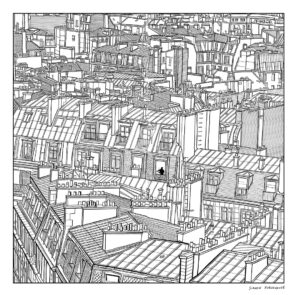
Paris Rooftops: A Scenic and Cultural Marvel.The City of Light, Paris, is renowned for its iconic landmarks such as the Eiffel Tower, the Louvre, and Notre-Dame Cathedral. However, it's not just these architectural marvels that make Paris so enchanting. The city's rooftops, with their charming blend of history, culture, and aesthetics, form an integral part of its unique character.
One of the most captivating aspects of Parisian rooftops is their diversity. From the elegant mansard roofs of Haussmannian buildings to the quaint, uneven slates of Montmartre, these rooftops reflect centuries of architectural evolution. The iconic zinc rooftops of Paris are not only visually appealing but also tell the story of urban development throughout the city's history.
Paris rooftops have not only shaped the city's skyline but also influenced art, literature, and cinema. Countless artists, from Henri Cartier-Bresson to Camille Pissarro, have drawn inspiration from these views. The famous Impressionist paintings that capture the changing light and atmosphere of the city often include these rooftops, highlighting their significance in the artistic narrative of Paris.
The idea of Parisian rooftops also conjures a sense of romance and nostalgia. Innumerable love stories, both in literature and film, have been set on these rooftops. It's as if the steep pitches and quaint chimneys create an atmosphere of intimacy and secrecy, making them ideal locations for clandestine meetings and passionate confessions.
Beyond their aesthetic appeal, Paris rooftops serve practical purposes as well. The rooftop gardens, known as "les toits-terrasses," offer respite from the bustling streets below. These hidden oases provide a peaceful escape for residents and visitors alike, offering breathtaking views of the city. Such places allow people to relax, dine, or simply admire the beauty of the city from a unique vantage point.
Moreover, the history of Paris is written in its rooftops. The city's historic district, Le Marais, boasts some of the oldest and most well-preserved rooftops in Paris, with their timber beams dating back to the Middle Ages. The UNESCO-listed rooftops of Mont-Saint-Michel, a stunning abbey perched atop a rocky island, also showcase the artistry of traditional roofing techniques that have endured through the centuries.
The Parisian rooftops are not just a visual delight; they're a testament to the city's resilience. Paris has withstood fires, wars, and revolutions, yet its rooftops have remained, rebuilt and refurbished, symbolizing the unwavering spirit of the city and its people.
In conclusion, Paris rooftops are more than just architectural features; they are cultural symbols, a source of artistic inspiration, and a glimpse into the city's rich history. They remind us that a city's character is not solely defined by its famous landmarks but also by the intricate details that make it unique. Paris rooftops are a testament to the enduring allure of this iconic city, offering a viewpoint that encapsulates its rich culture and history. The next time you wander the streets of Paris, don't forget to look up, for above you lies a world of hidden beauty, charm, and timeless stories.
Tristram Fieldhouse 3d Portrait in acrylic bronze.
3D Resin Printing Portraits. In the ever-evolving landscape of technology, 3D printing has emerged as a groundbreaking innovation, revolutionizing various industries. Among its many applications, one that stands out for its fusion of art and technology is 3D resin printing portraits. This remarkable art form has gained popularity in recent years, captivating artists, photographers, and enthusiasts alike. This essay explores the artistry of 3D resin printing portraits, shedding light on its evolution, techniques, and its profound impact on the world of portraiture.
The Evolution of 3D Resin Printing Portraits
Traditional portraiture has a long and storied history, with painters capturing the essence of their subjects through brush and canvas. However, 3D resin printing has introduced a new dimension to this art form. The evolution of 3D resin printing portraits can be traced to the 1980s when the first 3D printing technologies emerged. Over the years, the technology advanced, enabling artists to create incredibly detailed and lifelike portraits. Today, 3D resin printing is a powerful tool for translating the human form into tangible, three-dimensional sculptures.
Techniques and Process
Creating 3D resin printing portraits involves several intricate steps. The process typically begins with capturing the subject's image through photography or 3D scanning. High-resolution images are crucial to ensure the final print captures the subtle nuances of the subject's features. Once the digital representation is ready, it is converted into a 3D model using specialized software.
The 3D model is then sent to a 3D resin printer. In the printing phase, liquid resin is selectively cured by a laser or UV light, layer by layer, until the final portrait is complete. This layering technique allows for an unprecedented level of detail and realism. After printing, the sculpture is cleaned, cured, and post-processed to achieve the desired finish. The final result is a lifelike representation of the subject, making every detail, from the contours of the face to the texture of the skin, vividly tangible.
The Impact on Portraiture
3D resin printing portraits have had a profound impact on the world of portraiture. They offer a level of realism and detail that traditional methods struggle to match. These portraits immortalize subjects in three dimensions, making them come alive in a way that 2D art cannot replicate. Artists can push the boundaries of their creativity, experimenting with unique poses, styles, and even unconventional materials for printing. It has also become a popular choice for memorializing loved ones or capturing moments in time, such as pregnancy belly casts and baby scans.
Furthermore, 3D resin printing opens up new possibilities for collaboration between artists, photographers, and technologists. The fusion of art and technology has given rise to a vibrant community of creators and innovators, pushing the boundaries of what is achievable in portraiture.
Conclusion
3D resin printing portraits are a testament to the remarkable fusion of art and technology. The evolution of this art form, its intricate techniques, and its profound impact on the world of portraiture are evidence of the ever-expanding horizons of human creativity. As 3D printing technology continues to advance, it is likely that 3D resin printing portraits will further redefine the boundaries of what is possible in the world of art, captivating audiences with its lifelike representations and innovative approaches to portraiture.
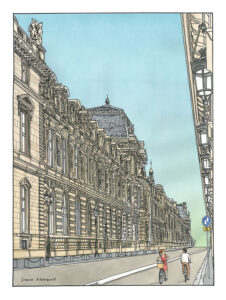
Rue de Rivoli (English: "Rivoli Street") is a street in central Paris, France. It is a commercial street whose shops include leading fashionable brands.[citation needed] It bears the name of Napoleon's early victory against the Austrian army, at the Battle of Rivoli, fought on 14–15 January 1797.[citation needed] Developed by Napoleon through the heart of the city, it includes on one side the north wing of the Louvre Palace and the Tuileries Gardens.
The Rue de Rivoli is an example of a transitional compromise between an environment of prestigious monuments and aristocratic squares, and the results of modern town-planning by municipal authorities.
Rue de Rivoli as it runs through Le Marais, in Paris' 4th arrondissement.The new street that Napoleon developed through the heart of Paris includes on one side the north wing of the Louvre Palace, (which Napoleon extended) and the Tuileries Gardens. Upon completion, it was the first time that a wide, well designed and aesthetically pleasing street bound the north wing of the Louvre Palace. Napoleon's original section of the street opened up eastward from the Place de la Concorde. Builders on the north side of the Place Louis XV, (as it then was named) between the Rue de Mondovi and Rue Saint-Florentin, had been constrained by letters patent in 1757 and 1758 to follow a single façade plan. The result was a pleasing uniformity, and Napoleon's planners extended a similar program, which resulted in the arcades and facades that extend for almost a mile along the street.[citation needed]
The restored Bourbon King Charles X continued the Rue de Rivoli eastwards from the Louvre, as did King Louis-Philippe. Finally, Emperor Napoleon III extended it into the 17th-century quarter of Le Marais (see: Right Bank). Beneath the Rue de Rivoli runs one of the main brick-vaulted, oval-sectioned sewers of Paris' much-imitated system, with its sidewalks for the sewer workers.[citation needed]
In 1852, opposite the wing of the Louvre, Baron Haussmann enlarged the Place du Palais-Royal that is centred on the baroque Palais Royal, built for Cardinal Richelieu in 1624 and willed to the royal family, with its garden surrounded by fashionable commercial arcades. At the rear of the garden is the older branch of the Bibliothèque Nationale, in the Rue Richelieu.[citation needed]
North of the Rue de Rivoli, at the point where the Grands Boulevards crossed an enormous new square, the new opera house was built. The Opera Garnier is a monument to the construction of the Second Empire. Just behind the opera house can be found the largest department stores, such as the Galeries Lafayette and Printemps.
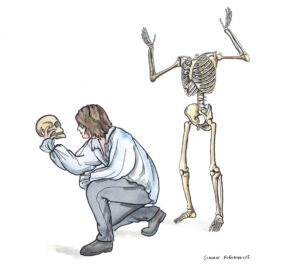
Where does the skull appear in Shakespeare’s Hamlet?
The skull appears in Act 5, Scene 1 of Hamlet. This scene, commonly known as the “gravedigger scene”, was used by Shakespeare to create some comic relief in the tragic Hamlet plot.
Generally, comic relief is meant to lessen the dramatic tension, and to give some sort of relief to the audience by injecting humorous or ironic elements into the play. But, in the case of Shakespeare’s tragedies, the comic relief is more than first meets the eye.
Like in Hamlet, the gravedigger scene uses comedy to comment on larger issues regarding life, death, and Christianity. This portion of this scene where Hamlet is conversing with a skull introduces much complexity. Hamlet’s monologue centered on the skull revolves closely around the vanity of life and the existential crisis within a man.
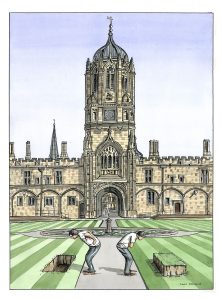
Christ Church Oxford is a constituent college of the University of Oxford in England. The college is associated with Christ Church Cathedral, Oxford, which serves as the college chapel and whose dean is ex officio the college head.
Like its sister college, Trinity College, Cambridge, it was traditionally considered the most aristocratic college of its university. It is the second wealthiest Oxford college by financial endowment (after St John’s) with an endowment of £436m as of 2015.
Christ Church has produced thirteen British prime ministers, more than any other Oxbridge college.
The college was the setting for parts of Evelyn Waugh’s Brideshead Revisited, as well as a small part of Lewis Carroll’s Alice’s Adventures in Wonderland. More recently it has been used in the filming of the movies of J. K. Rowling’s Harry Potter series and also the film adaptation of Philip Pullman’s novel Northern Lights (the film bearing the title of the American edition of the book, The Golden Compass). Distinctive features of the college’s architecture have been used as models by a number of other academic institutions, including the National University of Ireland, Galway, which reproduces Tom Quad. The University of Chicago and Cornell University both have reproductions of Christ Church’s dining hall (in the forms of Hutchinson Hall and the dining hall of Risley Residential College, respectively). ChristChurch Cathedral in New Zealand, after which the City of Christchurch is named, is itself named after Christ Church, Oxford. Stained glass windows in the cathedral and other buildings are by the Pre-Raphaelite William Morris group with designs by Edward Burne-Jones.
Christ Church is also partly responsible for the creation of University College Reading, which later gained its own Royal Charter and became the University of Reading.
The first female undergraduates matriculated at Christ Church in 1980.